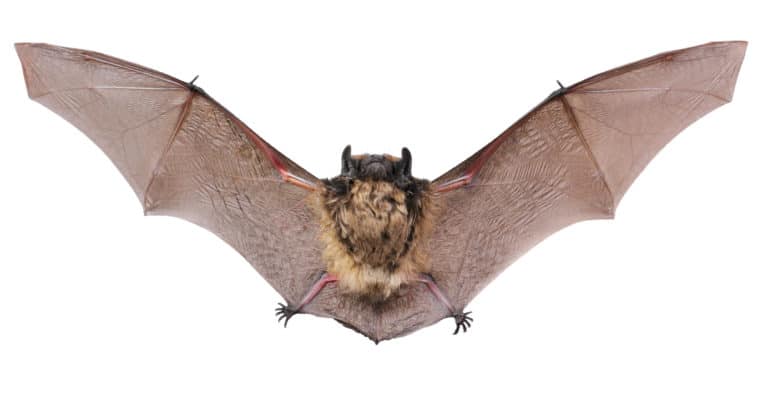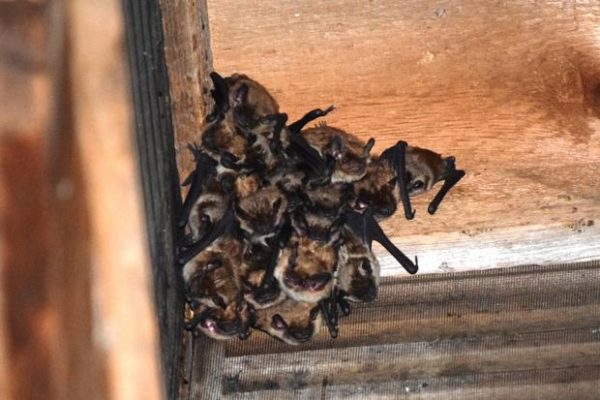
There’s an odor in your house. You hear squeaking sounds. You’re pretty sure you have bats in your attic, and you want them back outside where they belong. But did you know there is a window of time when bat exclusion can safely and legally be performed? And have you heard of bat maternity colonies? Modern Pest knows all about it, and we’re here to help!
Who’s in your attic?
There are about 45 species of bats in the U.S., but only colonizing bat species live in attics. The two most common bats found in New England are the little brown bat and the big brown bat. The maternity season for both bats is approximately June 1 through August 15.
When bats are present in an attic, it’s usually the odor that you’ll notice first. Bats leave a lot of waste behind. Each bat can leave 20 guano pellets a day. Bat waste doesn’t just smell bad, it also corrodes wood and drywall and grows mold. If the bat colony is large enough, you might also notice the noise they make.
Got bats? Modern has the solution! Learn more about our humane wildlife exclusion methods.
Why have they moved in?
All the bats living in your attic are female. Male bats roost outdoors in trees and other structures. A group of female bats is called a maternity colony. They’re using your attic as a safe place to give birth to and raise their babies, or pups. Females only give birth to one pup per year. Pups are unable to fly for several months. Mothers can carry them when they fly, but only until they are too big. Then the pups must remain in the roost while their mothers retrieve food for them. Most maternity colonies contain about 40 bats, plus their 40 babies.

The Bat Calendar
There is a moratorium on bat exclusion because of the bat pups living in the attic. Removing bats from an attic involves installing one-way doors that allow bats to exit, but not return. This only affects adult bats who can fly and would leave remaining flightless baby bats to starve. Sometimes they’ll even crawl down the walls of your home searching for food. They’ll either end up in your living space or die in the walls. Mother bats can also damage your home or fly into living spaces while trying to get back to their babies.
The bat calendar is based on the weather and when food is available. When it warms up, insects become active and the bats are ready to wake up and eat.
The Year of a Bat:
- January through February is when bats hibernate in a safe place and sleep upside down.
- March depends on the bat’s climate. If it’s cold, they’ll keep sleeping. If it’s warm enough and insects are available to eat, then they’ll wake up and emerge.
- April is when all bats come out of hibernation, or torpor. They’ll eat to restore fat lost during the winter. Male bats gather to form bachelor colonies. Breeding with female bats begins.
- May is when males return to their bachelor colonies and females form maternity colonies. Bats often return to their previous bachelor and maternity colony locations.
- In June, females consume large quantities of insects to build up fat and energy in preparation for the birth and raising of their young. The gestation period is between 40 days and six months depending on the species.
- By July, most baby bats are born. Mothers must keep them warm and provide milk. Nursing lasts about four weeks.
- By August, the pups have grown much larger and will start to fend for themselves. Maternity colonies begin to break apart.
- September through October is when bats begin to prepare for hibernation again. They consume large amounts of food and find places to roost for the winter.
- During November and December, bats settle into their roosting place and begin to hibernate.
Think you have a bat issue? Call 1-800-323-7378 or click here to request service today!
The Modern Solution
The first step in ridding your home of bats is calling Modern Pest to schedule a wildlife inspection. The Wildlife Control team starts by thoroughly inspecting the exterior of your home for evidence of bats. Bats only need a gap of 3/8 of an inch to squeeze through. Our professionals will then devise a customized plan to safely and legally perform a bat exclusion.
Possible steps of the inspection and bat exclusion process include:
- Examining the eaves, ridge caps, and fascia boards of your home, and looking for possible entry points like holes or gaps where the roof comes together.
- Checking for bat guano (droppings) around possible entry sites.
- Inspecting the attic for any signs of entry and guano.
- If the presence of bats is detected, our Wildlife professionals will likely install one-way doors at access points so bats cannot return after they leave to look for food.
- Gaps will be sealed up. Eventually, the one-way doors will be removed, and the holes sealed with mesh wire.
If you think you have bats in your attic based on smells, sounds, or simply seeing them enter and exit, call Modern Pest’s Wildlife Control team to schedule an inspection. Our Wildlife Control team will devise a plan to safely gets bats out of your home and keep them out.
